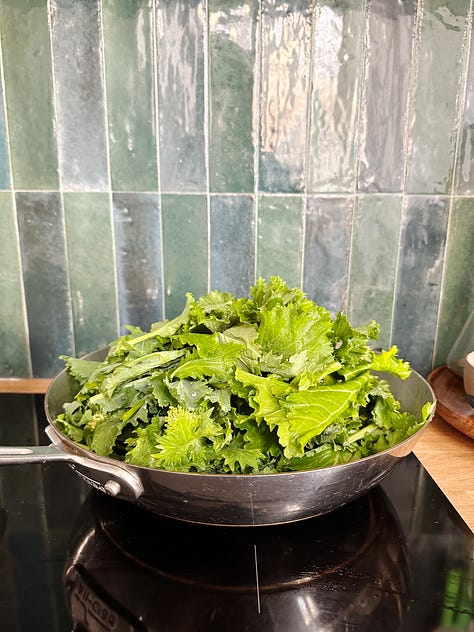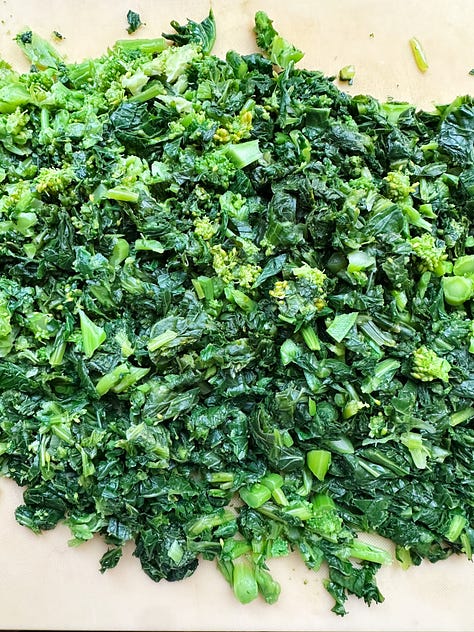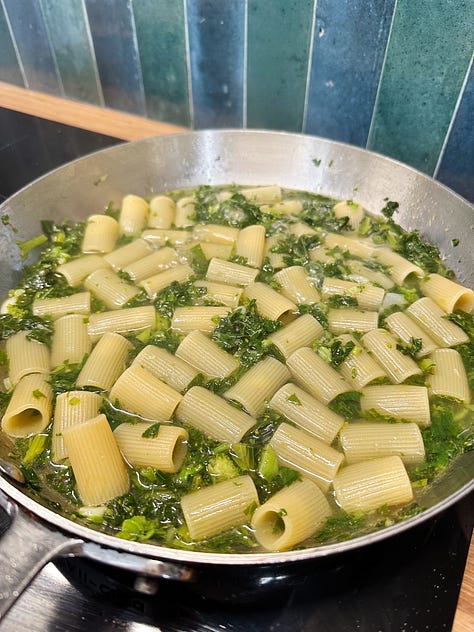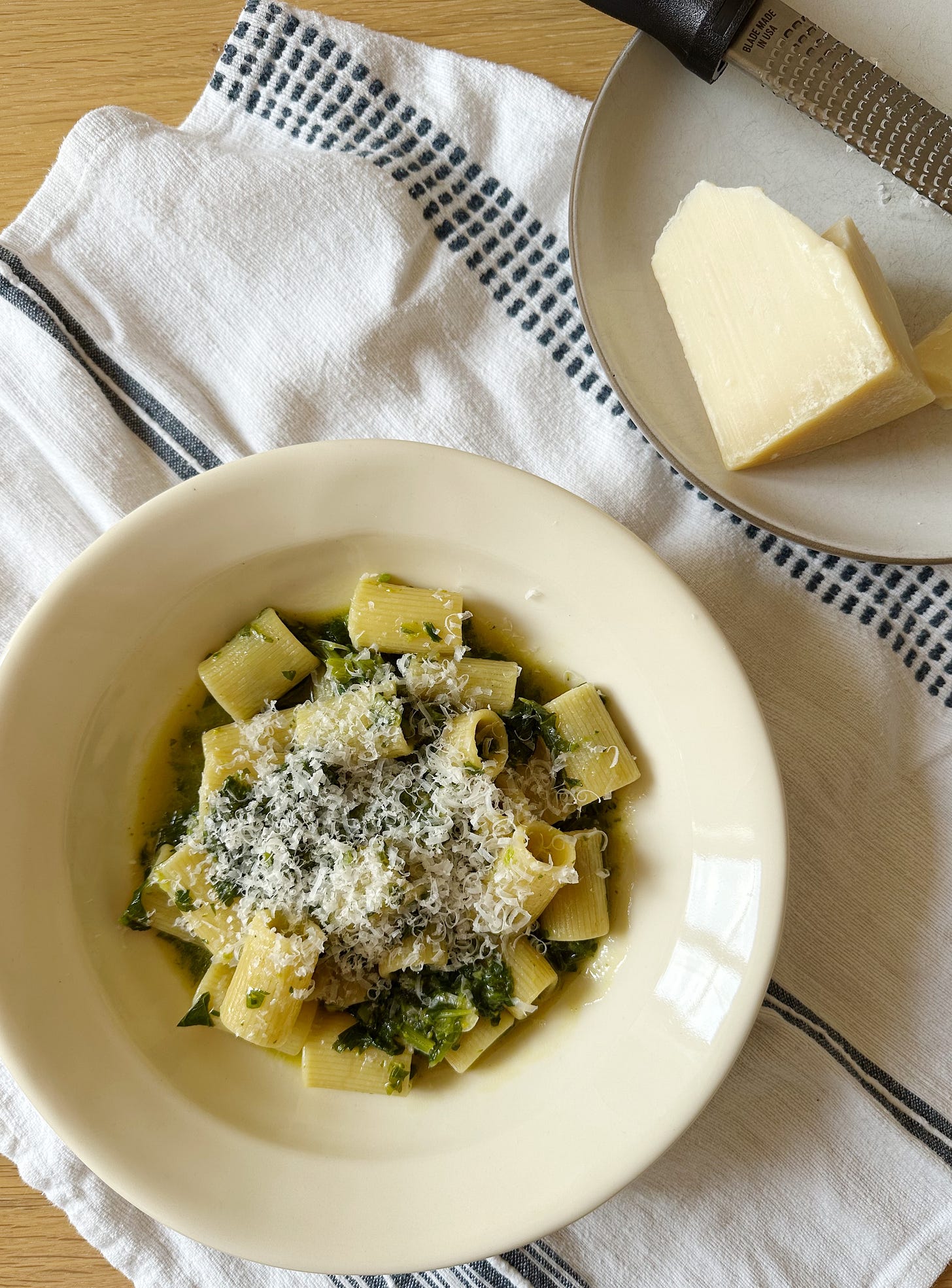The simple pasta I can't stop making and our ever-growing guide to Puglia.
Plus, a bit of This & That.
Bitter Greens for the Win
A few months ago, we started getting a weekly organic produce box delivered to our apartment in Rome, and honestly, it's been a total game-changer. Everything in the box is organic, and apart from a few outliers like avocados or lemons grown in Sicily, it's all sourced from nearby farms in the Lazio region.
Now, I know what some of you might be thinking—aren't you in Italy? Isn't everything organic? While it's true that food regulations here are significantly stricter than in the U.S.—with fewer pesticides, chemicals, and preservatives allowed—farmers can still use certain treatments on their crops. Andre and I have always tried to buy organic and as local as possible, but at the fruit and veg markets in Rome (also when we were in Turin), that's not as easy as you'd think. Produce is rarely labeled bio (organic), and when you ask, the vendors often brush off the question or encourage you to try it and see if you like the taste. But, even if the taste is fantastic, I still want to know if there are any chemicals and pesticides in the produce I am purchasing.
Enter our new produce box from a company called Zolle. A medium box arrives every Thursday, overflowing with gorgeous, seasonal, local, organic produce. It costs €38 and is plentiful enough to carry us through almost an entire week, and if you want, you can add on organic cheese, eggs, meat, pasta, and other pantry staples to your order. And, because it's all seasonal, you're truly cooking with what's growing at that very moment.
Lately, one of the regulars in our box has been a big bag of cime di rapa—also known as broccoli rabe or rapini. This leafy green, a staple in southern Italian cuisine, has a bitter, earthy flavor and is often sautéed with anchovy, garlic, olive oil, and chili flakes and tossed with pasta in a dish called orecchiette con cime di rapa. Despite the name, it's not actually related to broccoli but is closer to turnips and mustard greens. It's packed with vitamins A, C, and K, fiber, and antioxidants. If you like the stronger flavor of bitter greens, you will love this vegetable.
The thing about cime di rapa is that it doesn't last long (at least not in my Italian fridge)—within a day or two, the leaves begin to turn yellow—so I've had to figure out how to use up a giant bag of these greens quickly. The solution? This simple and delicious pasta dish. Traditionally, as I mentioned above, it includes chili flakes and orecchiette, but I've been keeping it even more minimalist: just anchovy, garlic, olive oil, cime di rapa, and some mezze rigatoni (because that's what I had, and let me tell you, it is fantastic!). When the ingredients are good, that's all you need. And when you get it right? It's pure comfort food—so simple, so satisfying. We've had it three weeks in a row, and I even made it for a dinner party the other night. Easily one of my favorite things I've cooked recently.
PASTA WITH CIME DI RAPA
Serves 4
12 ounces dried pasta (I've been using La Mezza Manica Rigata, which is a shape similar to a rigatoni but shorter. If you want to go more traditional with the dish, use orecchiette)
Extra virgin olive oil
1-2 high-quality anchovy fillets depending on size and how much you like the flavor (I use oil-packed anchovies)
3 garlic cloves, peeled and thinly sliced
3 cups of steamed or blanched cime di rapa, finely chopped (read notes below for prep)
Sea salt
Black Pepper
Parmigiano Reggiano
PREPPING CIME DI RAPA:
You can blanch the cime di rapa in a pot of boiling salted water for 1-2 minutes and then finely chop it after it has cooled. Or, you can steam it in a pan like I do. Here are the instructions for steaming it in a pan. One large bunch of cime di rapa (about 8-10 packed cups should yield the 3 cups needed for the recipe). Make sure to discard the thick, woody ends of the greens. Soak and rinse the greens in several changes of cold water, removing any dirt or unwanted particles. I usually wash them in my salad spinner, placing the greens inside, filling it with water, draining it, and then repeating 2-3 times until the water runs clear. On the final draining of water, leave just the water droplets that cling to the leaves from the soak, and set the bowl aside.
Place a large sauté pan on the stovetop and add the slightly wet greens into the pan. Add a pinch of sea salt, turn the heat on medium, and cover the pan. Cook for several minutes, occasionally checking and stirring until the greens have steamed and completely wilted in the pan. Turn the heat off. Remove the wilted greens from the pan and set them aside in a bowl. Let them cool down, and then squeeze out any excess water. Run a knife through the greens several times, finely chopping them up. Set them aside until you are ready to make the pasta.



TO MAKE THE PASTA:
Bring a large pot of water to a boil. Once boiling, generously salt the water and add in the pasta to cook for 4-5 minutes.
While the pasta cooks, coat the bottom of a large sauté pan with a thin layer of olive oil. Turn the heat to medium and add in the anchovies. Cook for a minute, moving the anchovies around so they break down and melt into the oil. Add in the garlic and continue cooking until the garlic is tender but not brown, another minute. Add the cime di rapa, a pinch of sea salt, and a little more olive oil. Stir to coat and cook until you are ready to add the pasta (If your cime di rapa starts to stick to the pan, add a splash of the pasta water). Once the pasta has hit the 4-5-minute mark (it will still be very undercooked), scoop it out and add it directly into the pan with the cime di rapa. Slowly add pasta water, ladle by ladle, into the pan as needed, and cook and stir the pasta. Add more water and olive oil if necessary throughout the cooking process until the pasta is al dente (always tasting along the way), but make sure you allow the sauce to reduce and thicken at the end. It's a delicate balance, so make sure you are paying attention as the pasta gets close to being done.
Once it is finished, divide the pasta between four bowls. Finish with a generous grating of Parmigiano Reggiano, a drizzle of extra virgin olive oil, and some freshly cracked black pepper.
Our Every-Growing Guide To Puglia
I know a lot of you are starting to plan your summer travel, so I’ve been working quickly to gather all of our recommendations so that you can have the best trip possible. From beautiful masserias, to incredible beaches and culinary hidden gems, our list is filled with places that won’t disappoint. And, as many of you know Andre’s family is from Puglia, so this list will keep growing and growing, as we continue to return to this magical place year after year.
This & That
Spent an incredible afternoon this past weekend at this beautiful organic farm and hotel just outside of Rome.
Valleybrink Road is having a huge sale! Use code BRIGHTEN for 30% off all gifts. Whether it’s celebrating the arrival of a new baby, sending some comfort to a friend, or celebrating a birthday, let’s brighten someone’s day together!








